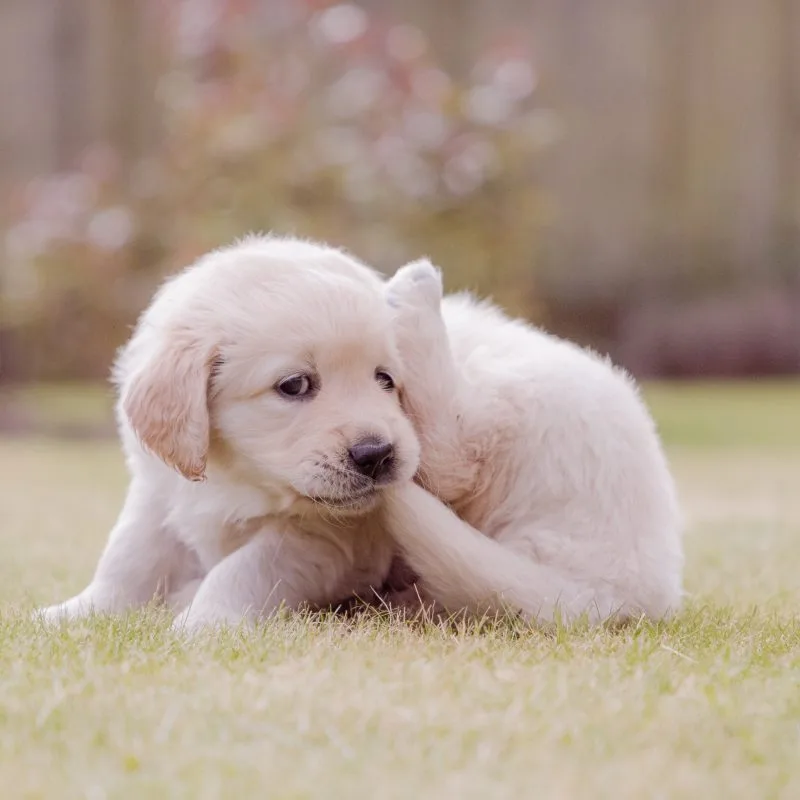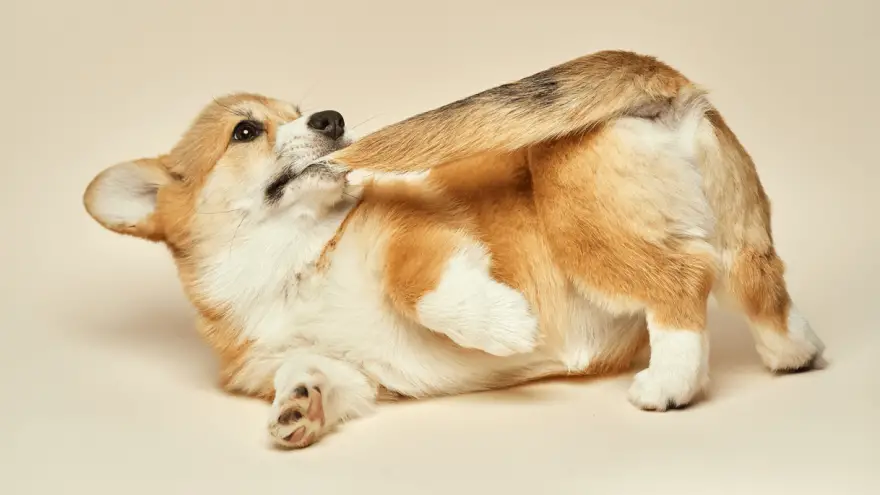Tail biting in dogs: Do you have a tail biting puppy? If so, you’re probably looking for ways to help stop your puppy from resorting to expensive medical treatments. Fortunately, there are a variety of home remedies that can help.
Table of Contents
From reducing stress and providing distractions to trying supplements and more, these 8 home remedies will give your pup relief and help him stop biting his tail.
Keep reading to learn more about why your puppy bites his tail and how to find the right solution for your puppy.
What is tail biting in dogs?
Tail biting in dogs is a behavior in which a dog bites or chews its tail. This behavior can be distressing to pet owners because it is a sign of anxiety or stress. If the dog bites too hard it can also lead to physical injuries. There are many causes of tail biting in dogs.
The most common is boredom or lack of physical activity, as dogs often chew their tails if they are not getting enough exercise. Other possible causes include separation anxiety, pain, discomfort, or a skin condition such as dermatitis.
Also Read: Blonde German shepherd all you need to know about
If your dog exhibits this behavior, it is important to take them to the vet to rule out any medical causes. If no medical cause is found, you can try to reduce stress by providing more mental and physical stimulation, such as regular walks and playtime.
What are the possible causes of tail-biting in dogs?

Tail biting in dogs is a behavior problem that can occur for a variety of reasons.
- This can be caused by medical problems such as skin allergies that cause the dog to bite its tail in an attempt to relieve irritation.
- It can also be caused by physical pain or discomfort, such as an injury to the tail or a tight collar. Anxiety and boredom are also common causes of tail biting; Dogs may engage in this behavior when stressed or lacking stimulation.
- Finally, some dogs bite their tails because they are bored and looking for something to do.
Identifying the cause of tail biting is important to properly address the problem. If your dog exhibits this behavior, it is best to consult a veterinarian or a certified dog trainer. They can help you identify the cause of the tail biting and provide the necessary advice and guidance to resolve the problem.
8 Home Remedies for tail biting in dogs
Tail biting is a common problem in dogs, and while it may not be a serious problem, it can cause discomfort and anxiety. Fortunately, there are some home remedies that can help curb your puppy’s tail biting habit. Tail biting is often a sign of stress and anxiety, so the first step is to get to the root of the problem. If your puppy is anxious for any reason, it could be because of a new home, changes in the family, or boredom.
Once you identify the cause of the problem, you can begin to take steps to reduce your puppy’s tail biting. Here are 8 home remedies for dog tail biting that will help your pup become more relaxed and less prone to tail biting.
1. Distraction with toys
Distracting your puppy with a toy or treat is a great way to reduce tail biting. Not only does it take their mind off their tails, it also helps reduce stress and anxiety. Keep a variety of toys and treats around the house so you can provide an easy distraction when you notice your puppy biting his tail.
2. Increase exercise and mental stimulation
Exercise is an important part of any puppy’s day, but it’s especially important for dogs prone to tail biting. Physical activity not only helps them burn off excess energy, but also provides mental stimulation that helps reduce stress and anxiety. Try to take your puppy out for walks or playtime several times a day.
3. Provide a comfortable environment
Making sure your puppy is comfortable in their environment is key to reducing tail biting. Make sure their bedding is comfortable and their favorite toys are within easy reach. It is also important to give them a quiet place to relax where they feel safe from any potential stressors.
4. Monitor barking behavior
Barking is a common sign of stress and anxiety, so monitoring your puppy’s barking behavior is an effective way to reduce tail biting. If you notice your puppy barking more than usual, take a few moments to figure out what’s causing the stress.
5. Prevent boredom
Boredom can be a major cause of tail biting, so it’s important to keep your puppy entertained throughout the day. Give them puzzles and interactive toys that will keep them engaged and help reduce boredom.
6. Provide appropriate chew toys
Chew toys are a great way to divert your puppy’s attention away from their tail. Look for toys that are designed to be chewed, as these are less likely to perish quickly and provide longer distraction.
7. Use bitter sprays
Bitter sprays are a great way to prevent your puppy from biting his tail. Spray the area around their tail with a bitter-tasting spray and this will help discourage them from biting.
8. Choose the appropriate treats
Treats are a great way to reward your puppy for not wagging his tail, but it’s important to choose the right treats. Look for treats that are low in calories and fat, as these are healthier for your pup.
Tail biting is a common problem in dogs, but with the right home remedies, you can help curb your puppy’s tail biting habit. Try some of the remedies above and see what works best for your pup. With a little patience and consistency, you can reduce your puppy’s tail biting in no time.
How to Stop a Dog from Biting Its Tail
Tail biting can be a frustrating and painful habit for dogs, and it’s essential to address the underlying causes to prevent it from happening. Here are some effective solutions to stop your dog from biting its tail:
Solution for Food Allergies
Food allergies can cause skin irritation, itchiness, and discomfort for dogs, leading them to bite their tails. If you suspect your dog has a food allergy, consult with a veterinarian to determine the best diet options.
Solution for Parasites
Parasites, such as fleas and ticks, can also cause skin irritation and itching, leading to tail biting. Regularly check your dog for parasites and use appropriate preventative measures, such as flea and tick medication.
Solution for Hot Spots and Other Skin Problems
Hot spots and other skin problems can also cause your dog to bite its tail. Consult with a veterinarian to determine the best course of treatment for your dog’s specific skin issues.
Other Solutions
Aside from addressing the underlying causes, you can also try some of the following solutions:
- Provide plenty of exercise and mental stimulation to alleviate boredom and reduce stress
- Consider using a cone or other deterrent to prevent your dog from biting its tail
- Use positive reinforcement training to discourage tail biting behavior and promote good behavior
By addressing the underlying causes and implementing these solutions, you can help prevent your dog from biting its tail and promote a happier, healthier pet.
Solutions for Anxiety, Stress, and Boredom
If your dog is biting its tail out of anxiety, stress, or boredom, it’s important to address these underlying emotional issues to prevent them from causing further harm to your pet. Here are some solutions:
Calming Techniques
One of the most effective ways to calm your dog’s anxiety and stress is through deep pressure therapy. This involves applying gentle, consistent pressure to your dog’s body with a weighted blanket or a compression vest. Another calming technique is aromatherapy, which uses essential oils like lavender and chamomile to promote relaxation.
Interactive Toys
Dogs that are bored or anxious may benefit from interactive toys that keep them mentally stimulated. Puzzle toys and treat-dispensing toys can provide a fun and engaging distraction for your pet, preventing them from turning to tail biting out of boredom.
Exercise and Playtime
Regular exercise and playtime can go a long way in helping your dog overcome stress and anxiety. Take your dog on daily walks, play fetch, and engage in other activities that allow your pet to burn off excess energy and release endorphins, which promote feelings of happiness and well-being.
“Calming techniques, interactive toys, and exercise can all help alleviate anxiety, stress, and boredom in dogs, potentially reducing tail biting.”
Solutions for Glandular Problems
Glandular problems can be caused by a variety of factors, including genetics, hormone imbalances or tumors. These issues can lead to discomfort, pain, and excessive licking, biting, and gnawing of the tail.
If your dog is exhibiting these symptoms, it’s essential to take them to the vet for a proper diagnosis. If glandular problems are the root cause of your dog’s tail biting, there are several solutions that your vet may recommend.
Medication
Your vet may prescribe medication to treat your dog’s glandular problems. For example, if your dog has hypothyroidism, hormone replacement therapy may be used to regulate the hormone levels and reduce tail biting. In some cases, anti-inflammatory medications may also be recommended to ease inflammation and pain.
Surgery
In severe cases, surgery may be required to remove tumors or correct other issues that are causing glandular problems. Your vet will discuss this option with you if it’s necessary for your pet’s health.
Dietary Changes
Dietary modifications may be recommended to help address glandular problems. For instance, for dogs with hypothyroidism, switching to a diet that’s lower in fat and higher in protein may be beneficial. In some cases, adding supplements, such as omega-3 fatty acids, to your dog’s diet may also help improve their glandular health.
Remember, it’s important to work closely with your vet to diagnose and treat glandular problems. With the right solutions and care, your furry friend can find relief from tail biting and enjoy a happier, healthier life.
Conclusion
Tail biting in dogs can be a frustrating problem. This could be a sign of depression, stress or other underlying health issues. Fortunately, there are some home remedies that can help curb this behavior.
The most important thing is to understand why your dog is biting its tail in the first place. It could be because of boredom, loneliness, anxiety or many other reasons. Once you identify the cause, you can start looking for solutions to fix it.
- First and foremost, it’s important to provide your dog with plenty of mental and physical stimulation. It includes daily walks, interactive toys and puzzle games. If tail biting is caused by boredom, these activities can help keep your dog occupied and entertained.
- Second, make sure your puppy has plenty of chew toys and bones. This will help reduce their urge to bite their tail and keep them occupied when they are alone. Chew toys and bones are also great for their dental health, so it’s a win-win situation.
- Third, it’s important to make sure your puppy has a safe place to sleep and rest. This means setting up a dog bed or crate that they can retreat to. This gives them a safe retreat to go to when they are overwhelmed or anxious.
- Finally, it is important to provide verbal and physical reassurance when your puppy bites his tail. Let them know that this is not acceptable behavior and that you are there to help them. You can also try to distract them from their behavior by offering a toy or treat.
In conclusion, tail biting in dogs is a frustrating problem to deal with. However, by understanding the reasons behind this and implementing the above home remedies, you can help curb this behavior and keep your puppy’s tail safe.

